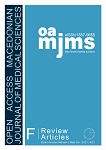Cell Phone Acne: New Acne Clinical Features in the Coronavirus Disease-19 Era
DOI:
https://doi.org/10.3889/oamjms.2021.6872Keywords:
Cell phone acne, Coronavirus disease-19, Electronic deviceAbstract
Technological developments in telecommunications, especially cell phone, enable us to keep communicate without meeting each other. Especially during the latest coronavirus outbreak, when people need to keep up social distance. Meanwhile, electronic devices such as smartphone, tablets, laptops, and light-emitting diode screens are the sources of visible lights that can emit high levels of short-wavelength visible light (blue region in the light spectrum). Prolonged exposure to high-energy blue light, heat dissipation from cell phone, friction, trapped sweat and oil, accumulation of dust, and increased bacterial growth can cause cell phone acne. Management of cell phone acne from prevention to combination therapy based on the results of the evaluation of the severity of acne is needed.
Downloads
Metrics
Plum Analytics Artifact Widget Block
References
Taheri M, Darabyan M, Izadbakhsh E, Nouri F, Haghani M, Mortazavi SA, et al. Exposure to visible light emitted from smartphones and tablets increases the proliferation of staphylococcus aureus: Can this be linked to acne? J Biomed Phys Eng. 2017;7(2):163-8. PMid:28580338
Keykhosravi A, Neamatshahi M, Mahmoodi R, Navipour E. Radiation effects of mobile phones and tablets on the skin: A systematic review. Adv Med. 2018;2018:9242718. https://doi.org/10.1155/2018/9242718 PMid:29850642 DOI: https://doi.org/10.1155/2018/9242718
Corazza M, Minghetti S, Bertoldi AM, Martina E, Virgili A, Borghi A. Modern electronic devices: An increasingly common cause of skin disorders in consumers. Dermatitis. 2016;27(3):82-9. https://doi.org/10.1097/der.0000000000000184 PMid:27172301 DOI: https://doi.org/10.1097/DER.0000000000000184
Singh M, Pawar M, Maheswari A, Bothra A, Khunger N. ‘Cell- phone acne’ epidemic during the COVID-19 pandemic. Clin Exp Dermatol. 2020;45(7):891-921. https://doi.org/10.1111/ ced.14360 PMid:32598514 DOI: https://doi.org/10.1111/ced.14360
Coats JG, Maktabi B, Abou-Dahech MS, Baki G. Blue light protection, Part I-effects of blue light on the skin. J Cosmet Dermatol. 2020;20(3):714-7. https://doi.org/10.1111/jocd.13837 PMid:33247615 DOI: https://doi.org/10.1111/jocd.13837
Dreno B, Shourick J, Kerob D, Bouloc A, Taïeb C. The role of exposome in acne: Results from an international patient survey. J Eur Acad Dermatol Venereol. 2019;34(5):1057-64. https://doi.org/10.1111/jdv.16119 PMid:31785166 DOI: https://doi.org/10.1111/jdv.16119
Yang J, Yang H, Xu, A, He L. A review of advancement on influencing factors of acne: An emphasis on environment characteristics. Front Public Health. 2020;8:450. https://doi.org/10.3389/fpubh.2020.00450 PMid:33042936 DOI: https://doi.org/10.3389/fpubh.2020.00450
Schwartz WF. Unilateral acne: The case for thermogenic aggravation, and a clue to basic acne therapy. Cutis. 1981;27(5):530-1. PMid:6453700
Sudy E. Unilateral acne after facial palsy. An Bras Dermatol. 2018;93(3):441-2. https://doi.org/10.1590/ abd1806-4841.20187437 PMid:29924238 DOI: https://doi.org/10.1590/abd1806-4841.20187437
Goh C, Cheng C, Agak G, Zanglein AL, Graber EM, Thiboutot DM, et al., editors. Fitzpatricks’ Dermatology in General Medicine. 9th ed. New York: McGraw Hill Companies; 2019. p.1391-412.
Jusuf NK, Putra IB, Sari L. Differences of microbiomes found in non-inflammatory and inflammatory lesions of acne vulgaris. Clin Cosmet Investig Dermatol. 2020;13:773-80. PMid:33122933
Zouboulis CC. Skin glands: Sebaceous, eccrine, and apocrine glands. In: Kang S, Amagai M, Bruckner AL, Enk AH, Margolis DJ, McMichael AJ, et al., editors. Fitzpatricks’s Dermatology in General Medicine. 9th ed. New York: McGraw Hill Companies; 2019. p. 70-88.
Totte JE, Feltz WT, Bode LG, Belkum A, Zuuren EJ, Pasmans SG. A systematic review and meta-analysis on Staphylococcus aureus carriage in psoriasis, acne and rosacea. Eur J Clin Microbiol Infect Dis. 2016;35(7):1069-77. https://doi.org/10.1007/s10096-016-2647-3 PMid:27151386 DOI: https://doi.org/10.1007/s10096-016-2647-3
Niebuhr M, Schorling K, Heratizadeh A, Werfel T. Staphylococcal α-toxin induces a functional upregulation of TLR-2 on human peripheral blood monocytes. Exp Dermatol. 2015;24(5):381-3. https://doi.org/10.1111/exd.12674 PMid:25707385 DOI: https://doi.org/10.1111/exd.12674
Bernadette I. Patogenesis Akne Vulgaris. In: Wasitaatmadja SM, editor. Jakarta: Badan Penerbit Fakultas Kedokteran Universitas Indonesia; 2018. p. 1-8.
Kapantow GM. Diagnosis Klinis Akne. In: Wasitaatmadja SM, editor. Jakarta: Badan Penerbit Fakultas Kedokteran Universitas Indonesia; 2018. p. 9-26.
Ramli R, Malik AS, Hani AF, Jamil A. Acne analysis, grading and computational assessment methods: An overview. Skin Res Technol. 2012;18(1):1-14. https://doi.org/10.1111/j.1600-0846.2011.00542.x PMid:21605170 DOI: https://doi.org/10.1111/j.1600-0846.2011.00542.x
Becker M, Wild T, Zouboulis C. Objective assessment of acne. Clin Dermatol. 2017;35(2):147-55. PMid:28274351 DOI: https://doi.org/10.1016/j.clindermatol.2016.10.006
Apple Support. Cleaning Your iPhone; 2020. Available from: https://www.support.apple.com/en-gb/ht207123. [Last accessed on 2021 May 16].
Wasitaatmadja SM, Arimuko A, Norawati L, Bernadette I, Legiawati L, editors. Pedoman Tata Laksana Akne di Indonesia. 2nd ed. Jakarta: Centra Communications; 2016. p. 1-16.
Tuchayi SM, Makrantonaki E, Ganceviciene R, Dessinioti C, Feldman SR, Zouboulis CC. Acne vulgaris. Nat Rev Dis Primers. 2015;1:15029. https://doi.org/10.1038/nrdp.2015.29 PMid:27189872 DOI: https://doi.org/10.1038/nrdp.2015.29
Zaenglein AL. Acne vulgaris. N Eng J Med. 2018;379(14):1343-51. PMid:30281982 DOI: https://doi.org/10.1056/NEJMcp1702493
Zaenglein AL, Pathy AL, Schlosser BJ, Alikhan A, Baldwin HE, Berson DS, et al. Guidelines of care for the management of acne vulgaris. J Am Acad Dermatol. 2016;74(5):945-73.e33. PMid:26897386 DOI: https://doi.org/10.1016/j.jaad.2015.12.037
Choi JM, Lew VK, Kimball AB. A single-blinded, randomized, controlled clinical trial evaluating the effect of face washing on acne vulgaris. Pediatr Dermatol. 2006;23(5):421-7. https://doi.org/10.1111/j.1525-1470.2006.00276.x PMid:17014635 DOI: https://doi.org/10.1111/j.1525-1470.2006.00276.x
Baumann L. Cosmeceuticals and skin care in dermatology. In: Kang S, Amagai M, Bruckner AL, Enk AH, Margolis DJ, McMichael AJ, et al. Fitzpatrick’s Dermatology. 9th ed. United States: McGraw Hill; 2019. p. 3803-19.
Zettersten EM, Ghadially R, Feingold KR, Crumrine D, Elias PM. Optimal ratios of topical stratum corneum lipids improve barrier recovery in chronologically aged skin. J Am Acad Dermatol. 1997;37(3):403-8. https://doi.org/10.1016/s0190-9622(18)30737-0 PMid:9308554 DOI: https://doi.org/10.1016/S0190-9622(18)30737-0
Downloads
Published
How to Cite
Issue
Section
Categories
License
Copyright (c) 2021 Kristin Stephanie Sembiring, Nelva Karmila Jusuf (Author)

This work is licensed under a Creative Commons Attribution-NonCommercial 4.0 International License.
http://creativecommons.org/licenses/by-nc/4.0








